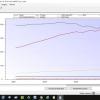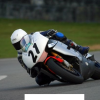Is this on Tmap sensor Or map sensor ?Retarding ignition from 57 is an oem feature, not an obd tuner feature. (i had the same loss of power feeling on my CS basemap on a hot day) On last years LOT day at Zandvoort Peter did change the 57 to a higher value on one of the suffering speedsters and the owner complained about performance loss. After checking with Peter later, he mentioned he leaves it to default 57 by default to protect the engine.

Supercharged Intake Temps
#101

Posted 22 June 2014 - 10:59 AM
#102

Posted 22 June 2014 - 11:00 AM
Is this on Tmap sensor Or map sensor ?
I'll check with the owner.
#103

Posted 22 June 2014 - 11:02 AM
#104

Posted 22 June 2014 - 11:03 AM
#105

Posted 22 June 2014 - 11:08 AM
Edited by CHILL Gone DUTCH, 22 June 2014 - 11:11 AM.
#106

Posted 22 June 2014 - 11:08 AM
#107

Posted 22 June 2014 - 11:09 AM
I've emailed Peter asking about how the retarding is built up.
#108

Posted 22 June 2014 - 11:09 AM
More compression will add more heat (and lots more noise).Based on the info here do you think there is a advantage with manifold intake temps with going to a smaller pulley ?
#109

Posted 22 June 2014 - 11:11 AM
That threshold is just too low on a boosted engine where the temp sensor has been relocated and is sat measuring the compressed charge.
That's why obdtuner customers work together with the designer to make the product better.
If somebody asks for a custom map where it starts retarding from 70 instead of 57, and the engine does not blow up......
#110

Posted 22 June 2014 - 11:12 AM
I understand that but we have a stablished that we are cooling manifold inlet temps with the air on wotMore compression will add more heat (and lots more noise).Based on the info here do you think there is a advantage with manifold intake temps with going to a smaller pulley ?
#111

Posted 22 June 2014 - 11:20 AM
That's fine and great. But you can't physically add support for further sensors and use the information from them or drivers for external things like water injection.That's why obdtuner customers work together with the designer to make the product better.
#112

Posted 22 June 2014 - 11:23 AM
I don't think we should get into a discussion about which is better Standalone or obd Comparing chalk and cheeseThat's fine and great. But you can't physically add support for further sensors and use the information from them or drivers for external things like water injection.That's why obdtuner customers work together with the designer to make the product better.
Edited by CHILL Gone DUTCH, 22 June 2014 - 11:23 AM.
#113

Posted 22 June 2014 - 11:25 AM
That's fine and great. But you can't physically add support for further sensors and use the information from them or drivers for external things like water injection.That's why obdtuner customers work together with the designer to make the product better.
Not entirely correct, example is the EGR being used as a wideband lambda.
Peter is also adding water injection functionality for v. 3
#114

Posted 22 June 2014 - 11:30 AM
Wonder if it pulls even more ignition as the temp rises more and more
I would assume so? depends what the correction table says
70 degrees on Tmap had a massive power loss
depends, once again, unless your into det or the map has pulled ignition timing, then not necessarily
So we've seen several data traces now where intake temp increases on smaller throttle opening/light load. And I have thought about the air path when the bypass is open. Struggling to conclude why temp goes up. So with the valve open, the manifold is in vacuum - that's what opened the valve. Here air is drawn in from the charger intake before the compressor directly into the manifold and I assume follows normal path from there - ie through the laminovas. So how is it getting heated to the point it's hotter than compressed air from the charger on WOT?think about the airpath when the engine in on very light load and the SC by-pass is open.
easy.
when the by-pass opens, the airflow is though the charger and back round the bypass, thus the air in the system goes through the (HOT) SC several times, unsurprisingly, this get's it quite hot, and all the more because at lot throttle openings, there's not much air to take up this heat
I no this doesn't show the actual numbers of power loss Bit it does show that there is significant loss on the second lap as the stage four turbo goes past me Earlier in video I have legs on the turbo in a straight line but when I hit the power on the straight I felt the power loss The Tmap was reading 70 degrees when power dropped badly
that's a turbo car, completely different set of issues.
air mass for a turbo is temp and pressure related *AFTER* the turbo, unlike with a (positive displacement) supercharger.
please try and understand what actually happens here, and stop mixing up different issues from different engine setup's.
with a SC install, unless you get to the point of having to pull timing to prevent det, a change in IAT after the intercooler makes zero odds to power, the only caveat to this is that with higher temps, the boost goes up so the parasitics will also rise a little, however, on a dyno it's almost impossible to actually see/measure this (and yes, I have tried a few times).
on a turbo, this is not true, as boost is actively controlled, so if the temps go up, the air becomes less dense, and as boost control will limit the absolute boost, you will have less air mass for a given boost, ie, less air = less power.
#115

Posted 22 June 2014 - 11:34 AM
#116

Posted 22 June 2014 - 11:42 AM
#117

Posted 22 June 2014 - 11:45 AM
Edited by Scuffers, 22 June 2014 - 11:48 AM.
#118

Posted 22 June 2014 - 11:53 AM
Right I see this now and it makes sense. I had the direction of flow though the bypass valve the wrong way around in my head. Thanks!easy. when the by-pass opens, the airflow is though the charger and back round the bypass, thus the air in the system goes through the (HOT) SC several times, unsurprisingly, this get's it quite hot, and all the more because at lot throttle openings, there's not much air to take up this heat
So we've seen several data traces now where intake temp increases on smaller throttle opening/light load. And I have thought about the air path when the bypass is open. Struggling to conclude why temp goes up. So with the valve open, the manifold is in vacuum - that's what opened the valve. Here air is drawn in from the charger intake before the compressor directly into the manifold and I assume follows normal path from there - ie through the laminovas. So how is it getting heated to the point it's hotter than compressed air from the charger on WOT?think about the airpath when the engine in on very light load and the SC by-pass is open.
#119

Posted 22 June 2014 - 11:56 AM
So the bypass valve is actually a way of reduced boost off throttle rather than avoiding compressing the air?
#120

Posted 22 June 2014 - 12:01 PM
I'm fully aware of what it can and can't do but you can't do anything with the EGR live. It's great re-purposing of the EGR input/output for logging purposes but of absolutely no use whilst the car is actually driving. Yup and you'll be another 150 down when that's released and you decide you want it and have to send your ECU back to Peter. Do that upgrade twice and you're in the territory of a more flexible standalone.Not entirely correct, example is the EGR being used as a wideband lambda. Peter is also adding water injection functionality for v. 3
1 user(s) are reading this topic
0 members, 1 guests, 0 anonymous users
















